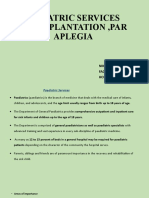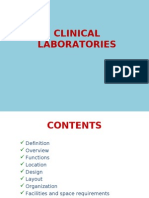0 ratings0% found this document useful (0 votes)
220 viewsIntensive Care Units: Progressive Patient Care Concept
Intensive Care Units: Progressive Patient Care Concept
Uploaded by
pdamodar2007Copyright:
Attribution Non-Commercial (BY-NC)
Available Formats
Download as PPT, PDF, TXT or read online from Scribd
Intensive Care Units: Progressive Patient Care Concept
Intensive Care Units: Progressive Patient Care Concept
Uploaded by
pdamodar20070 ratings0% found this document useful (0 votes)
220 views37 pagesOriginal Title
ICU
Copyright
© Attribution Non-Commercial (BY-NC)
Available Formats
PPT, PDF, TXT or read online from Scribd
Share this document
Did you find this document useful?
Is this content inappropriate?
Copyright:
Attribution Non-Commercial (BY-NC)
Available Formats
Download as PPT, PDF, TXT or read online from Scribd
Download as ppt, pdf, or txt
0 ratings0% found this document useful (0 votes)
220 views37 pagesIntensive Care Units: Progressive Patient Care Concept
Intensive Care Units: Progressive Patient Care Concept
Uploaded by
pdamodar2007Copyright:
Attribution Non-Commercial (BY-NC)
Available Formats
Download as PPT, PDF, TXT or read online from Scribd
Download as ppt, pdf, or txt
You are on page 1of 37
Intensive care units
Progressive patient care concept
Progressive patient care
Proposed by Florence Nightingale
Developed by Llewelyn Davis
• Intensive medical care
• Intensive nursing care
• Medium nursing care
• Low nursing care
• Self care
Trend in per capita health care costs
Adhikari, N. et al. Anesth Analg 2003;96:311-314
Copyright restrictions apply.
Health care costs as a percentage of gross national product (GNP) for Canada, the United
States, and the average of countries in the Organization for Economic Cooperation and
Development (OECD)
Adhikari, N. et al. Anesth Analg 2003;96:311-314
Copyright restrictions apply.
Intensive care units
• A unit that is staffed and equipped to look
after critically ill patients with potentially
reversible lesions and unable to
communicate their needs or require
intensive medical and nursing care.
Among the various types of services and
interventions offered in the hospital
setting, none have a greater drain on
overall resources than those provided to
the critically ill patient. Data
demonstrate that between 1986 and 1992,
approximately 1% of the total US gross
domestic product was spent on critical
care.
ICU
• Patients requiring advanced respiratory
support alone.
• Patients requiring support of two or more
organ systems
• Patients with chronic impairment of one or
more organ systems sufficient to restrict
normal activity and who require support for an
acute reversible failure of another organ
system.
HDU
• Patients requiring support for a single
failing organ system,
• but excluding those needing advanced
respiratory support.
• Patients requiring a level of observation
or monitoring not possible on a general
ward.
Types of ICUs
• Single specialty ICU
• Multispeciality ICU
• Closed unit or open unit
• 'Open Unit': Clinical management remains
responsibility of admitting consultant
• 'Closed Unit': Intensive care consultant
completely responsible for clinical
management
Factors to be considered in estimating
size of an ICU
• · Number of acute beds in hospital or catchment area
• · Type of acute bed (adult, paediatric)
• · Previously calculated occupancies of wards, HDU(s) and ICU(s)
• · History of refusals
• · Location of other 'high care' areas (other ICUs or HDUs in
hospital, other
• hospitals)
• · Number of operating theatres
• · Surgical specialties serviced and case mix (e.g. vascular,
cardiac, thoracic,
• emergency, urgent, elective)
• · Medical specialties (e.g. respiratory, cardiology)
• · A & E department
Factors to be considered in estimating
size of an ICU
• Subregional or regional services (e.g. neurosurgery,
maxillo-facial surgery,
• complex orthopaedic, renal services, oncology etc.)
• Ability to transfer patient to an off-site ICU (staff,
equipment, transport)
• Paediatric care
• Location motorways, holiday resort, mainline
transport terminal (rail, coach,air)
Physical facilities
• Location
• Number of beds –5% in general hospital, 10-15% in
specialty hospital
• Size of unit – 8 - 12 is ideal
• Areas- clinical, support, admn, public
• design considerations
area, floor, walls, roof, partitions,beds, electrical
installations,lighting, medical equipment,
nursing station, special procedure room
Patient module
• Ward-type ICUs should allow at least 225 square
feet of clear floor area per bed.
• individual patient modules should allow at least
250 square feet per room (assuming one patient
per room),
• provide a minimum width of 15 feet, excluding
ancillary space.
• A utility column (freestanding, ceiling mounted,
or floor mounted) is the preferred source of
electrical power, oxygen, compressed air and
vacuum, and should contain the controls for
temperature and lighting
ICU bed
• • Electric/Hydraulic Hospitals Beds
• • 2 to 4 pcs Bed Sections
• • Options
• • Side Rails
• Flexible head end
• Head pannel – 2 O2 out lets 2 suction inlets,2
compressed air out let,B P monitor
• • IV Pole
• •Trendelnberg and Reverse Trendelnberg
• • X-ray Cassette
• • Mattress
• • Side Tables etc.
Clinical area Patient module
• Cubicle/ non cubicle module
• Bed space – 2-3 times the normal ward bed – ward type
225sft, module type 250sft minimum width 15 ft
• Nursing station- location direct/indirect visualization
• Noise - <45dB day time, <40 evenings, <20 nights(intl
noise control)
• Electrical – separate feeder, 16 –24 out lets at each bed,36
inches from floor,
• Lighting – general-30fc,procedure- 150fc, night – 10-15fc
with dimmers
• Temp- 22-25 centigrade
• Air – 10-15 air changes/hr with positive pressure
• O2- 2outlets/bed, compressed air – 1-2 outlets/bed,
vacuum- 3 outlets/bed
Support services
• Work Areas and Storage.
• Toilet – entry for wheel chair,grab bar
panic button
• Clean and Dirty Utility Rooms.
• Equipment Storage.
• Nourishment Preparation Area.
• Supply and Service Corridors.
• Patient Transportation Routes.
Admn area
• Receptionist Area.
• Staff Lounge and rest rooms
• Conference Room.
Public area
• Visitors' Lounge/Waiting Room.
Staffing
• Medical
• Nursing
• auxiliary
Importance
• 3 times more nursing hours than general
ward
• Cost is 3-20 times more in establishing and
maintaining
• Lab expenditure may be about 30% of ICU
cost
• ALS varies from 2-12 days with average of
5days
Policies
• Admission
• Triage
• Treatment
• Discharge
• Infection control
• Teaching and research
• Quality
• Ideal occupancy –60-70%
Admission criteria
Rating System
• Level 1: Convincingly justifiable on scientific
evidence alone
• Level 2: Reasonably justifiable by available
scientific evidence and strongly supported by
expert critical care opinion
• Level 3: Adequate scientific evidence is lacking
but widely supported by available data and critical
care expert opinion
Discharge criteria
• A. When a patient's physiologic status has stabilized and
the need for ICU monitoring and care is no longer
necessary
• B. When a patient's physiological status has deteriorated
and active interventions are no longer planned, discharge
to a lower level of care is appropriate
Discharge criteria from Critical Care Units should be
similar to the admitting criteria for the next level of
care such as intermediate care where available.
Establishment of NICU
• Land – 20%
• Equipment – 67%
• Building – 12%
• Furniture – 1%
You might also like
- Hospital Literature StudyDocument24 pagesHospital Literature Studyarunavails93% (55)
- ETL Design TemplateDocument14 pagesETL Design TemplateachvmNo ratings yet
- Whitepaper: Welcome To VINCIDocument34 pagesWhitepaper: Welcome To VINCIandy sanjayaNo ratings yet
- Planning and Set Up of IcuDocument34 pagesPlanning and Set Up of Icuprashsubbu88% (34)
- Maternity HospitalDocument40 pagesMaternity HospitalMohd Salahuddin0% (2)
- Inpatient Services: Includes Nursing Station and The Beds It Serves With Supportive and Public AreasDocument14 pagesInpatient Services: Includes Nursing Station and The Beds It Serves With Supportive and Public Areaspdamodar2007No ratings yet
- Gold Cyanide SolutionDocument2 pagesGold Cyanide SolutionWalmir CristinoNo ratings yet
- Critical Care Nursing 2 2048Document66 pagesCritical Care Nursing 2 2048Subhada GosaviNo ratings yet
- Concept of Critical Care 1234207545923257 2Document108 pagesConcept of Critical Care 1234207545923257 2jhingalala339No ratings yet
- Concepts of Critical Care: Gamar Akalal Sugala Clinical Resource NurseDocument44 pagesConcepts of Critical Care: Gamar Akalal Sugala Clinical Resource NurseGummie Akalal SugalaNo ratings yet
- Emergency Medical ServicesDocument48 pagesEmergency Medical ServicesRachana VishwajeetNo ratings yet
- 21 - Icu Management - and - OrganisationDocument89 pages21 - Icu Management - and - OrganisationVamshiNo ratings yet
- ,er ND Er CareDocument57 pages,er ND Er CareMichels Garments S.H Nawaz HosieryNo ratings yet
- Outpatient Services Hospital AdministrationDocument48 pagesOutpatient Services Hospital Administrationdiksha3797dwivediNo ratings yet
- 09 HospitalDocument24 pages09 HospitalRob Mitchelle Menor MoralesNo ratings yet
- Organization of Intensive Care UnitDocument39 pagesOrganization of Intensive Care UnitHarshil Dave100% (2)
- HOSPITALDocument30 pagesHOSPITALsahib khanNo ratings yet
- Seminar Progressive Patient CareDocument16 pagesSeminar Progressive Patient CareGayathri R50% (2)
- Icu Design and InfrastructureDocument19 pagesIcu Design and InfrastructureSaradhiJannNo ratings yet
- Out Patient DepartmentDocument52 pagesOut Patient DepartmentAnonymous ibmeej971% (7)
- Organization of Intensive Care Unit: Department of Anesthesiology M.L.B. Medical College, JhansiDocument40 pagesOrganization of Intensive Care Unit: Department of Anesthesiology M.L.B. Medical College, JhansiFalguni PaulNo ratings yet
- Hospital and Healthcare FacilitiesDocument23 pagesHospital and Healthcare FacilitiesGueanne ConsolacionNo ratings yet
- Upana Critical Care TrialDocument15 pagesUpana Critical Care TrialScribdTranslationsNo ratings yet
- Jiya - (ICU and HDU)Document26 pagesJiya - (ICU and HDU)Jiya RobertNo ratings yet
- Critical Care NursingDocument41 pagesCritical Care NursingAbirajan50% (2)
- HospitalDocument16 pagesHospitalshrenik_28No ratings yet
- Concept of Critical Care Nursing NUR 409: by Dorcas MainaDocument74 pagesConcept of Critical Care Nursing NUR 409: by Dorcas Mainamwaithira71682No ratings yet
- 4th Weekly Report - M2021ho021Document18 pages4th Weekly Report - M2021ho021Dr.Marufa FaruqiNo ratings yet
- Emergency DepartmentDocument25 pagesEmergency DepartmentphanikrNo ratings yet
- Critical Care NursingDocument25 pagesCritical Care NursingMonalikaNo ratings yet
- Intensive Care Unit Orientation: Prof. Precy P. LantinDocument17 pagesIntensive Care Unit Orientation: Prof. Precy P. LantinJamaica Leslie NovenoNo ratings yet
- Setting Up An Intensive Care UnitDocument43 pagesSetting Up An Intensive Care Unital_usman_pkNo ratings yet
- Dr. Bayan-Transformation of Health Care in Saudi Arabia - EditedDocument23 pagesDr. Bayan-Transformation of Health Care in Saudi Arabia - EditedMaram AbdullahNo ratings yet
- Introduction To IcuDocument41 pagesIntroduction To IcuzhaimeangirlNo ratings yet
- Criticalcare Designandfacilities 170412044012Document34 pagesCriticalcare Designandfacilities 170412044012Vinay SahuNo ratings yet
- Structure and Organization of Emergency ServicesDocument12 pagesStructure and Organization of Emergency ServicesScribdTranslationsNo ratings yet
- The CT Scanning Machine Rotates On An Axis and Takes Various 2D Images of An Individual's Body From Multiple Angles.)Document5 pagesThe CT Scanning Machine Rotates On An Axis and Takes Various 2D Images of An Individual's Body From Multiple Angles.)bharath venugopal rao tamarapalliNo ratings yet
- Icu AdtDocument18 pagesIcu AdtLeonardo LiswojoNo ratings yet
- Aau-Chs School of Anesthesia: Anesthetic Considerations For Pediatrics-Outpatient (Day Care Surgeries)Document58 pagesAau-Chs School of Anesthesia: Anesthetic Considerations For Pediatrics-Outpatient (Day Care Surgeries)agatakassaNo ratings yet
- Administrative Stationery at The HospitalDocument36 pagesAdministrative Stationery at The HospitalScribdTranslationsNo ratings yet
- Community Health Care CentreDocument49 pagesCommunity Health Care CentreAr Ishank Suri100% (1)
- IPD FunctionsDocument11 pagesIPD FunctionsYashwanth GoudNo ratings yet
- Pediatric Services Transplantation, ParaplegiaDocument29 pagesPediatric Services Transplantation, Paraplegiaayana ammuNo ratings yet
- 2019PGDHQM051 - Vyas Sukumaran - HQM2 - Assignment 1Document7 pages2019PGDHQM051 - Vyas Sukumaran - HQM2 - Assignment 1Vyas SukumaranNo ratings yet
- Hospital: Literature Study PresentationDocument41 pagesHospital: Literature Study PresentationGeetakshri Jajoria100% (1)
- Concept of Critical Care 1234207545923257 2Document106 pagesConcept of Critical Care 1234207545923257 2Mourian AmanNo ratings yet
- Death and DischargeDocument18 pagesDeath and DischargeBala GaneshNo ratings yet
- Hospital PlaningDocument52 pagesHospital Planingniju_grgNo ratings yet
- Roles and Responsibilities of Nurses in Various DepartmentsDocument19 pagesRoles and Responsibilities of Nurses in Various DepartmentsT HaripriyaNo ratings yet
- Nursing The Icu PatientsDocument31 pagesNursing The Icu PatientsInnocentNo ratings yet
- Concept of Critical CareDocument106 pagesConcept of Critical CareMaria VisitacionNo ratings yet
- Hospital Planning and Des 2797627Document36 pagesHospital Planning and Des 2797627rashmi123vaishNo ratings yet
- WARD MANAGEMENT, ClassDocument25 pagesWARD MANAGEMENT, ClassSushmitaBhaumik100% (29)
- 6 Hospital Ward ManagementDocument11 pages6 Hospital Ward Managementsurabhi kumariNo ratings yet
- Peran Perawat Keperawatan KritisDocument21 pagesPeran Perawat Keperawatan KritisRudi HariyonoNo ratings yet
- Medical CenterDocument38 pagesMedical CenterKhea Micole MayNo ratings yet
- Hospital Design Data CollectionDocument59 pagesHospital Design Data CollectionSHERYL SHEKINAH E ARCH-2019 BATCH100% (6)
- Concept of Critical CareDocument11 pagesConcept of Critical CareShesly PhilominaNo ratings yet
- JCI Accreditation Presentation 4Document53 pagesJCI Accreditation Presentation 4Osama MarzoukNo ratings yet
- TÉCNICAS DEL AUXILIAR DE ENFERMERÍA EN EL ÁREA DE QUIRÓFANOFrom EverandTÉCNICAS DEL AUXILIAR DE ENFERMERÍA EN EL ÁREA DE QUIRÓFANONo ratings yet
- Manual for Iv Therapy Procedures & Pain Management: Fourth EditionFrom EverandManual for Iv Therapy Procedures & Pain Management: Fourth EditionNo ratings yet
- Clinical case in the emergency room of a patient with an ischemic strokeFrom EverandClinical case in the emergency room of a patient with an ischemic strokeNo ratings yet
- Oracle Interview Questions and Answers: SQL 1. To SeeDocument3 pagesOracle Interview Questions and Answers: SQL 1. To SeeBernard A EkohNo ratings yet
- Inventory Management: Excel Books FINANCIAL MANAGEMENT, Dr. Sudhindra BhatDocument11 pagesInventory Management: Excel Books FINANCIAL MANAGEMENT, Dr. Sudhindra Bhatpdamodar2007100% (1)
- Medical RecordsDocument17 pagesMedical Recordspdamodar2007No ratings yet
- Emergency Room Design and ManagementDocument21 pagesEmergency Room Design and Managementpdamodar2007No ratings yet
- Intensive Care UnitDocument26 pagesIntensive Care Unitpdamodar2007No ratings yet
- BMW PresentationDocument45 pagesBMW Presentationpdamodar2007No ratings yet
- Clinical LaboratoriesDocument24 pagesClinical Laboratoriespdamodar200788% (8)
- Clinical LaboratoriesDocument24 pagesClinical Laboratoriespdamodar200788% (8)
- Defnition of NursingDocument30 pagesDefnition of Nursingpdamodar2007No ratings yet
- Emergency Room Design and ManagementDocument21 pagesEmergency Room Design and Managementpdamodar2007No ratings yet
- Defnition of NursingDocument30 pagesDefnition of Nursingpdamodar2007No ratings yet
- Planning An Operation Theatre ComplexDocument65 pagesPlanning An Operation Theatre Complexpdamodar200794% (67)
- Intensive Care UnitDocument26 pagesIntensive Care Unitpdamodar2007No ratings yet
- Facilty Planning and DesignDocument7 pagesFacilty Planning and Designpdamodar2007100% (1)
- Promoting and Building A New HospitalDocument16 pagesPromoting and Building A New Hospitalpdamodar200767% (3)
- Chapter 2 - Strategy and Human Resources PlanningDocument18 pagesChapter 2 - Strategy and Human Resources Planninggrace zumba.canadaNo ratings yet
- TESDA - Program Registration Forms Land-BasedDocument26 pagesTESDA - Program Registration Forms Land-BasedBobby Olavides SebastianNo ratings yet
- The Coca-Cola CompanyDocument23 pagesThe Coca-Cola CompanyLexie Gabriana-Reyes83% (6)
- Electronic Contribution Collection List SummaryDocument3 pagesElectronic Contribution Collection List SummaryMICAH ELLANo ratings yet
- Mod1 PDFDocument277 pagesMod1 PDFKavya SharmaNo ratings yet
- Esg Reporting Guide enDocument28 pagesEsg Reporting Guide enSalah Eddine100% (2)
- Assignment HR Audit SKMDocument6 pagesAssignment HR Audit SKMAiman BegNo ratings yet
- Octane UK 2024 - 05Document196 pagesOctane UK 2024 - 05STE7ENNo ratings yet
- Allis Chalmers 710c 714c 715c Loader Backhoe Parts CatalogDocument20 pagesAllis Chalmers 710c 714c 715c Loader Backhoe Parts CatalogRichard100% (58)
- AYUSHYA SUKTAM - Gleanings From Sanskrit LiteratureDocument5 pagesAYUSHYA SUKTAM - Gleanings From Sanskrit LiteratureRajesh RamakrishnanNo ratings yet
- Al On Internal Flows KjiouDocument2 pagesAl On Internal Flows KjiouAravind SomasundaramNo ratings yet
- PDC 1 ChecklistDocument4 pagesPDC 1 ChecklistMageswary KunalanNo ratings yet
- Midterm Exam.: College of Architecture & Environmental PlanningDocument9 pagesMidterm Exam.: College of Architecture & Environmental PlanningHaruNo ratings yet
- Chapter1 Components of Computer System HardwareDocument26 pagesChapter1 Components of Computer System HardwareRiron CassandraNo ratings yet
- Gaurav SirDocument8 pagesGaurav SirAnkit GuptaNo ratings yet
- 2020 05 01 CaptureDocument68 pages2020 05 01 Captureenock-readersNo ratings yet
- Agua Caliente Tribe Complaint PDFDocument45 pagesAgua Caliente Tribe Complaint PDFCelesteNo ratings yet
- 11Document8 pages11Legese TusseNo ratings yet
- The Jugaad Technology (Indigenous Innovations) (A Case Study of Indian Origin)Document13 pagesThe Jugaad Technology (Indigenous Innovations) (A Case Study of Indian Origin)Supradip DasNo ratings yet
- General Excavation Safety ChecklistDocument2 pagesGeneral Excavation Safety Checklistjithin shankarNo ratings yet
- QCDD Fire Safety Standards Civil Defense CommentsDocument7 pagesQCDD Fire Safety Standards Civil Defense CommentsjaimonjoyNo ratings yet
- Criminal Law and JurisprudenceDocument12 pagesCriminal Law and JurisprudenceMark Kenneth RoblesNo ratings yet
- WHLP-Kindergarten-First Quarter (Week 1-10)Document10 pagesWHLP-Kindergarten-First Quarter (Week 1-10)Mhai MabungaNo ratings yet
- RZR 0916 CDocument23 pagesRZR 0916 Chasnol100% (1)
- Chapter 16Document28 pagesChapter 16Kevin HenricoNo ratings yet
- Reliability Ab PDFDocument4 pagesReliability Ab PDFLuis Alberto SanchezNo ratings yet
- FHMM1314 MBI Topic 3 Student Version 202301Document58 pagesFHMM1314 MBI Topic 3 Student Version 202301Rhinndhi SakthyvelNo ratings yet





































































































